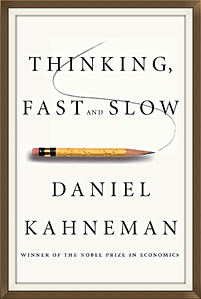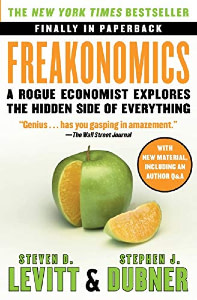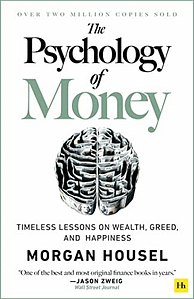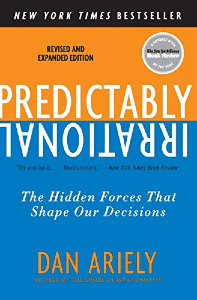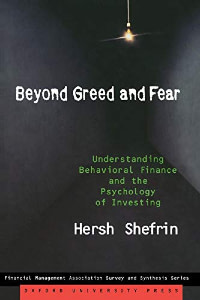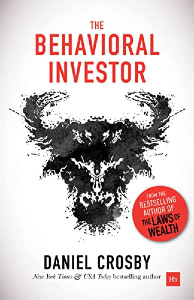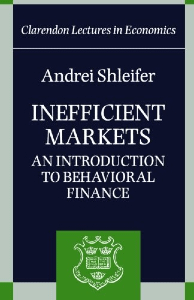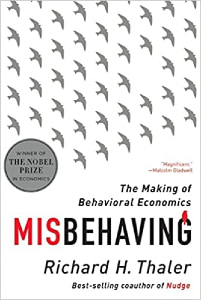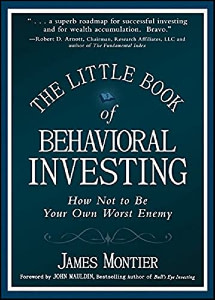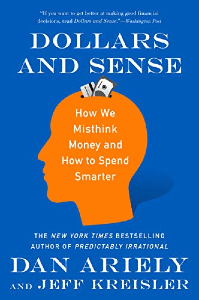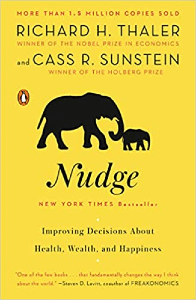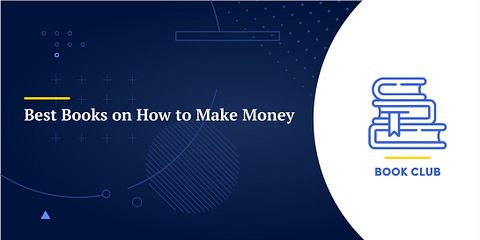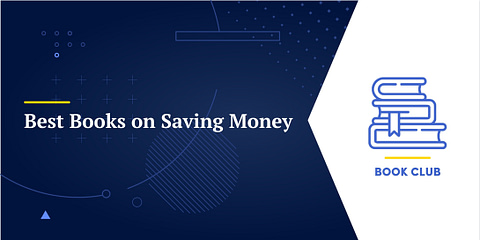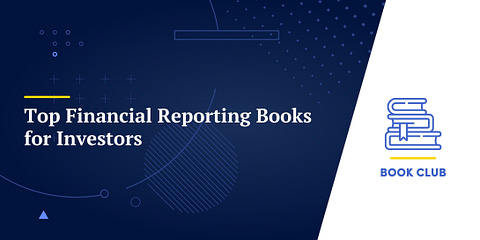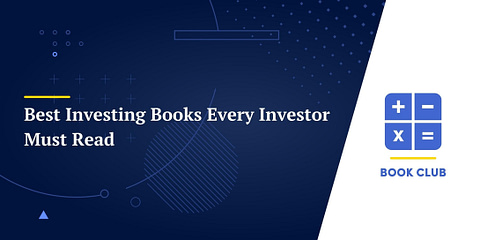Investors often let emotions and biases guide their financial decisions, leading them to make careless mistakes. Individuals managing their personal finances also frequently put reason and facts in the backseat.
How can you become more conscious of risk, act in your best interest, and prevent emotions and biases from getting the best of you? Behavioral finance books can help.
The following titles will teach you how to make rational decisions and fewer mistakes, whether you’re managing personal finance or investments.
We considered several factors when selecting books for this list, such as the author’s expertise, awards, critical acclaim, and online reviews. We also included new and noteworthy titles to provide readers with a diverse range of options and keep up-to-date with the latest trends.
1. Thinking, Fast and Slow
by Daniel Kahneman
Thinking, Fast and Slow (2011) by Daniel Kahneman is among the best investment books for beginners. It delves into cognitive biases and people’s two conflicting modes of thinking: intuitive and deliberate.
It explains how processing information instinctively can be helpful but often leads to errors in judgment. Putting emotions aside and allowing time for logical reasoning can help you make rational decisions.
🔑 Key takeaways:
- Intuition and deliberation in behavioral economics;
- How overconfidence causes biased, subjective decisions;
- Objectively processing and responding to statistical information;
- Prospect theory.
This best-seller’s primary themes are the exploration of many cognitive biases and heuristics. Grab your copy to understand how to overcome them and take charge of your financial behavior.
📖 Favorite quote from the book:
Our comforting conviction that the world makes sense rests on a secure foundation: our almost unlimited ability to ignore our ignorance.
✍️ About the author: Daniel Kahneman is a world-renowned psychologist and economist famous for his findings on behavioral economics, which earned him the 2002 Nobel Prize in Economic Sciences. He developed prospect theory, co-founded TGG Group, and teaches psychology and public affairs at Princeton University.
2. Freakonomics
A Rouge Economist Explores the Hidden Side of Everything
by Stephen J. Dubner & Steven Levitt
Freakonomics (2005), by Stephen J. Dubner & Steven Levitt, is an unusual book that correlates economics and sociocultural phenomena. It explains ways for you to apply economic theory to numerous seemingly unrelated subjects, including pop culture.
The book also discusses controversial ideas like abortion and gun violence, for which it has received criticism. However, the authors tie them back to economic principles with behavioral arguments.
🔑 Key takeaways:
- Economic knowledge can correct the irrational behavior governing our lives;
- We need economics to understand human behavior;
- Nature and nurture affect how people behave;
- Freeing yourself from conventional thinking can make you a better economist.
Freakonomics might be a challenging read, but it is worth it if you are anything but traditional.
📖 Favorite quote from the book:
Information is a beacon, a cudgel, an olive branch, a deterrent—all depending on who wields it and how. Information is so powerful that the assumption of information, even if the information does not actually exist, can have a sobering effect.
✍️ About the authors: Steven Levitt is an economist who won the John Bates Clark Medal in 2003. He co-founded TGG Group and the Center for RISC at the University of Chicago, where he works as an economics professor.
Stephen J. Dubner is a journalist, author, and host of the Freakonomics Radio podcast. He co-authored several Freakonomics sequels and has received many awards for his journalistic work.
3. The Psychology of Money
Timeless Lessons on Wealth, Greed, and Happiness
by Morgan Housel
The Psychology of Money (2020), by Morgan Housel, isn’t your ordinary behavioral finance book targeting investing and practical tips. It focuses on perceptions of money and their impact on financial decision-making.
The book contains 19 short stories that expand our understanding of economics, wealth, greed, success, and happiness, highlighting the impact of psychology on financial decisions.
🔑 Key takeaways:
- Be reasonable instead of rational;
- Embrace market volatility;
- Save money and wait for lucrative opportunities;
- Leave your ego out of the equation;
- Carefully plan investments and subsequent steps because not all strategies are winning.
This engaging read also tackles personal finance management, teaching the readers about the significance of wise spending and savings decisions on the journey to wealth.
📖 Favorite quote from the book:
A genius who loses control of their emotions can be a financial disaster. The opposite is also true. Ordinary folks with no financial education can be wealthy if they have a handful of behavioral skills that have nothing to do with formal measures of intelligence.
✍️ About the author: Morgan Housel is a financial journalist and behavioral finance expert who used to write for the Wall Street Journal and the Motley Fool. He is a partner at the Collaborative Fund and has won numerous awards, including the SABEW’s Best in Business Award and the New York Times Sydney Award.
4. Predictably Irrational
The Hidden Forces That Shape Our Decisions
by Dan Ariely
Predictably Irrational (2008), by Dan Ariely. is an excellent book for beginner investors and students studying behavioral finance. It reads like a story, containing personal anecdotes from everyday experiences to help readers delve into an investor’s mind.
Ariely uses exciting experiments and real-life examples to show how people act irrationally, even when intentionally trying to make a rational decision.
🔑 Key takeaways:
- Irrational behavior is systemic and predictable;
- Emotions stand in the way of good judgment;
- People put more value on free products than they actually have (the zero price effect);
- We overvalue owned objects due to emotional biases (the endowment effect);
- Predicting irrational behavior can help evaluate market sentiment.
Besides its valuable investment lessons, this book contains examples demonstrating that many people don’t use rational thought when comparing prices. For instance, we may expect a more expensive medicine to be more effective than its affordable counterpart, even if both are placebos.
Get your copy if you are looking for a thought-provoking read that might help you become more rational with finances.
📖 Favorite quote from the book:
The danger of expecting nothing is that, in the end, it might be all we’ll get.
✍️ About the author: Dan Ariely is a psychology and behavioral economics professor at Duke University, where he runs the Center of Advanced Hindsight research lab. He taught at MIT, co-founded several companies focusing on behavioral science, and has published several best-sellers, including Predictably Irrational and The Upside of Irrationality.
5. Beyond Greed and Fear
Understanding Behavioral Finance and the Psychology of Investing
by Hersh Shefrin
Beyond Greed and Fear (1999), by Hersh Shefrin, looks at how psychology influences financial decisions. Shefrin teaches investors how to prevent emotions, bias, and overconfidence from clouding their judgment.
The book delves into how we let mistakes increase our fear without learning the lessons those mistakes can teach. When we think we see profit, we become greedy and make the same mistakes over and over again. Investors can overcome the cycle of greed and fear by recognizing and avoiding cognitive biases and mistakes.
🔑 Key takeaways:
- The concepts of heuristic biases, frame dependence, and market inefficiency;
- Even seasoned professionals let emotions and cognitive biases guide their actions;
- Investment models don’t consider these fundamental elements of human behavior;
- Ignoring the effects of the psychology of investing leads to errors and financial losses.
You may tie this book’s themes to trading, but its primary focus is investing.
📖 Favorite quote from the book:
One of the most striking claims of behavioral finance is that heuristic-driven bias and frame dependence can cause prices to deviate from fundamental values for long periods.
✍️ About the author: Hersh Shefrin is an economist focusing on behavioral finance. He is a finance professor at Santa Clara University, where he previously taught economics, and writes for the Wall Street Journal, Forbes, Vox, and Huffington Post. He has published many research articles and books and won the Albert Nelson Marquis Lifetime Achievement Award in 2019.
6. The Behavioral Investor
by Daniel Crosby
The Behavioral Investor (2018), by Daniel Crosby, is among the top must-read books for investors. It delves deep into connections between human nature and finance and offers practical tips for better financial behavior and higher returns.
This book can help you increase self-awareness, avoid common investment pitfalls, overcome natural inclinations, improve your portfolio management and build wealth.
🔑 Key takeaways:
- The psychological, neurological, and sociological factors impacting your investment decisions;
- The four psychological tendencies (ego, conservatism, attention, and emotion) influencing investment behavior;
- Practical solutions to these problems and wealth management tips.
The author also proposes a rules-based behavioral investing (RBI) method for moving away from emotional biases and toward rational, evidence-based decision-making.
📖 Favorite quote from the book:
Far from seamlessly assimilating new ideas into our existing belief framework, research shows that we actually tend to get more firm in our cherished beliefs when those beliefs become challenged.
✍️ About the author: Daniel Crosby is a psychologist, asset manager, and behavioral finance expert helping companies maximize investment returns and build wealth. He’s a thought leader writing for Investment News and WealthManagement.com and producing the “Irrationality Index,” which measures greed and fear to forecast negative returns.
7. Inefficient Markets
An Introduction to Behavioral Finance
by Andrei Shleifer
The efficient market hypothesis (EMH) states that asset prices reflect all available information and have fair fundamental values. It assumes that all investors are rational and that pricing discrepancy is impossible due to arbitrage opportunities.
That is not the case with real-world financial markets. Institutional and psychological evidence challenge the EMH’s assumptions.
In Inefficient Markets (2000), Andrei Shleifer proposes behavioral finance as an alternative, presenting empirical evidence and theories for analyzing actual markets.
🔑 Key takeaways:
- Real-world financial markets are inefficient;
- Investors make irrational decisions due to cognitive biases;
- Behavioral finance helps accurately analyze financial data and forecast asset prices.
This book is an excellent read for beginners in behavioral finance. The author’s easily intelligible explanations of various financial market models help newbies understand and apply the knowledge in real life.
✍️ About the author: Andrei Shleifer is a financial, behavioral, and development economist, researcher, and author. He won the John Bates Clark Medal in 1999, co-founded LSV Asset Management, and taught at Princeton University and the University of Chicago. He has been an economics professor at Harvard University since 1991.
8. Misbehaving
The Making of Behavioral Economics
by Richard H. Thaler
Richard H. Thaler’s titles are among the most valuable behavioral finance books. The Nobel laureate’s Misbehaving (2017) is a gripping book you’ll want to read in one sitting because the wisdom and often humorous illustrations won’t let you put it down.
Thaler explains how people frequently make irrational financial decisions because they let emotional biases guide their actions. They misbehave, and markets move irrationally as a result.
🔑 Key takeaways:
- Investors are irrational and misbehave because of emotional biases;
- Misbehavior can have detrimental consequences;
- Behavioral economics provides a new lens to analyze economic theory;
The author’s personal experiences make the book even more engaging. Grab your copy if you want an entertaining and insightful read that can help you make wiser financial decisions.
📖 Favorite quote from the book:
The purely economic man is indeed close to being a social moron. Economic theory has been much preoccupied with this rational fool.
✍️ About the author: Richard H. Thaler is a behavioral economist, author, and columnist for The New York Times. He won the Nobel Prize in Economic Sciences in 2017 for outstanding contributions to behavioral economics. He has been an economics and behavioral science professor at the University of Chicago’s Booth School of Business since 1995.
9. The Little Book of Behavioral Investing
How Not to Be Your Own Worst Enemy
by James Montier
The Little Book of Behavioral Investing (2010), by James Montier, explains how human behavior affects financial markets and offers guidelines on maintaining a profitable investment portfolio.
The author shares insights into investors’ psychological pitfalls, such as emotions, hindsight bias, loss aversion, and overconfidence, and offers solutions to avoid them. He also explains the significance of learning from mistakes and overcoming behavioral challenges.
🔑 Key takeaways:
- Careful planning helps maintain investment discipline;
- Guesswork and failing to learn from mistakes can lead to losses;
- Focusing on low-risk assets helps overcome the fear of making investment decisions;
- Monitoring price fluctuations can help you make profitable decisions;
- Fundamental analysis is crucial to determine fair market values.
This short read is ideal for aspiring investors dipping their toes in financial markets. It offers a useful foundation for making psychology work in your favor and breaking the barriers hindering high returns.
📖 Favorite quote from the book:
Success in investing doesn’t correlate with IQ once you’re above the level of 100. Once you have ordinary intelligence, what you need is the temperament to control the urges that get other people into trouble in investing.
✍️ About the author: James Montier is a renowned economist with several behavioral and the author of several investing books. He is a fellow of the Royal Society of Arts and a visiting fellow at the University of Durham. He was the co-head of General Strategy at Société Générale and currently works as an asset allocation manager at GMO.
10. Dollars and Sense
How We Misthink Money and How to Spend Smarter
by Dan Ariely & Jeff Kreisler
Dollars and Sense (2017) is a page-turner that dives into the irrational world of personal finance and provides guidance on overcoming behavioral challenges. It’s a good choice for the reader who is more focused on personal finance than on investing.
The authors explore everyday topics to help us understand how emotions affect our financial choices and may cost us more than we think. They discuss how we perceive money and address the tendencies driving us to spend more than we should, from using credit cards for groceries to overpaying for items on vacation.
🔑 Key takeaways:
- How psychology affects your financial decisions;
- How to change your instincts for better financial decision-making;
- Practical advice on improving financial choices, including spending and saving more wisely.
This enjoyable read explains behavioral finance in an easy-to-understand language, infusing humor into real-life examples to help readers relate. It is a fascinating behavioral finance book for beginners.
📖 Favorite quote from the book:
Happiness too often seems to be less a reflection of our actual happiness and more a reflection of the ways in which we compare ourselves to others.
✍️ About the authors: Behavioral economist Dan Ariely has partnered with Jeff Kreisler, a lawyer, author, stand-up comedian, and behavioral science advocate. Kreisler is head of Behavioral Science at J.P. Morgan Chace, founding editor at PeopleScience, and an executive humor coach at Stanford Business School.
11. Nudge
Improving Decisions About Health, Wealth, and Happiness
by Richard H. Thaler & Cass R. Sunstein
Nudge (2008) is a fantastic read about the behavioral patterns that lead us to poor financial choices, negatively affecting our health, wealth, and happiness. It provides real-world scenarios and tips to improve our financial behavior.
The authors explain how people succumb to biases when making financial decisions and share enlightening examples from extensive research on behavioral science.
🔑 Key takeaways:
- “Choice architecture” can change consumer behavior by “nudging” people in the right direction without restricting options;
- Even a minor change can “nudge” people to make better decisions;
- Using the nudge theory to redesign our environment can help us live better lives.
The authors have rewritten this New York Times best-seller to share new research and personal experiences. Nudge: The Final Edition (2021) provides insights on personal finance, credit card debt, mortgages, retirement savings, climate change, medical care, and other areas where we can make better decisions for a more fulfilling life.
📖 Favorite quote from the book:
If you want to nudge people into socially desirable behavior, do not, by any means, let them know that their current actions are better than the social norm.
✍️ About the author: Behavioral economist and Nobel laureate Richard H. Thaler has teamed up with legal scholar Cass R. Sunstein in a collaboration for Nudge. Sunstein worked for the Obama administration, won the Holberg Prize in 2018, and taught at the University of Chicago Law School. He currently teaches at Harvard Law School as the Robert Walmsley University Professor.
12. The Winner’s Curse
Paradoxes and Anomalies of Economic Life
by Richard H. Thaler
The Winner’s Curse (1991) is a fascinating exploration of irrational economic behavior. Thaler tackles many paradoxes and anomalies of everyday economic life, explaining a common phenomenon in financial markets and value auctions: the winner’s curse.
The winner’s curse is an economic anomaly indicating that the winner is also a loser because they overestimate an item’s value and often overpay for it.
Thaler shares many real-world examples to support his wisdom, including auction bidders and consumers saving money on one product to spend the savings on another.
🔑 Key takeaways:
- Why people make irrational financial decisions;
- Economic paradoxes and anomalies, primarily the winner’s curse;
- Financial markets are inefficient.
This book may reveal essential economic wisdom, but it is slightly challenging for readers with no background in economics. It is a dense book with many mathematical examples that make it ideal for academic readers.
13. The Art of Contrary Thinking
by Humphrey B. Neill
Do you follow the pack as an investor or choose an oppositional course? The former can be risky, according to the late Humphrey B. Neill.
“When everyone thinks alike, everyone is wrong.”
This pearl of wisdom is one of many this renowned economist discussed in The Art of Contrary Thinking (1976). He explained the effects of herd mentality on investment decisions and financial markets and proposed a different thinking philosophy he applied when doing business or investing.
Contrary thinking can help investors capture the growing value from others following in their footsteps. It can also help forecast market shifts and prevent financial losses.
🔑 Key takeaways:
- The herd is usually wrong;
- Contrary thinking can help you stay on the right track;
- An oppositional strategy can help you prevent or minimize losses.
This book gives you a formula for thinking like a successful investor, making better decisions, leveraging value, understanding how people behave, and generating accurate forecasts. It is still a relevant read after nearly half a century.
📖 Favorite quote from the book:
When governments, including our own, carry great debt loads, it behooves thoughtful citizens to recall occasionally the disastrous inflations of the past, the illusions of bootstrap economics—which always are accompanied by crowd hysteria.
✍️ About the author: Humphrey B. Neill was an economist, investment thinker, and World War I lieutenant. He dedicated his life to analyzing and writing about the folly of herd mentality and its effects on investment decisions. Always encouraging people to question the consensus and providing mountains of evidence, he earned the title “father of contrary opinion” from Life magazine.
Other Behavioral Finance Books We Considered
There are many behavioral finance books out there. We’ve rounded up the best, but when you’ve finished reading those, you also might like to read some of the following.
- Your Money and Your Brain by Jason Zweig
- Seeking Wisdom: From Darwin to Munger by Peter Bevelin
- Why Smart People Make Big Money Mistakes by Gary Belski
- Loaded: Money, Psychology, and How to Get Ahead Without Leaving Your Values Behind by Sarah Newcomb
- The Signal and the Noise by Nate Silver
- Behavioral Finance and Wealth Management: How to Build Investment Strategies That Account for Investor Biases by Michael M. Pompian
Conclusion
These behavioral finance books deserve a spot on every financially focused bookshelf, from investors and asset managers to individuals seeking personal finance advice.
Their wisdom and real-world examples can be valuable tools for profitable investments and better economic decisions devoid of emotions and biases.


